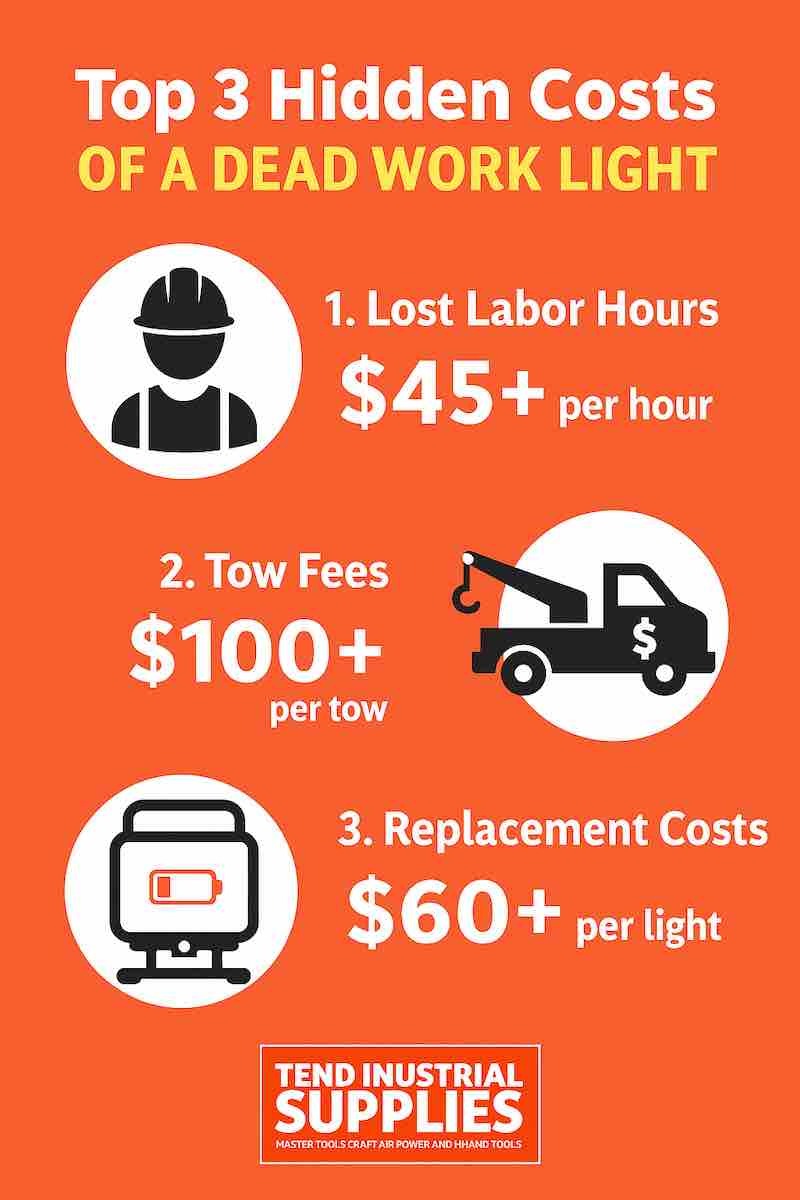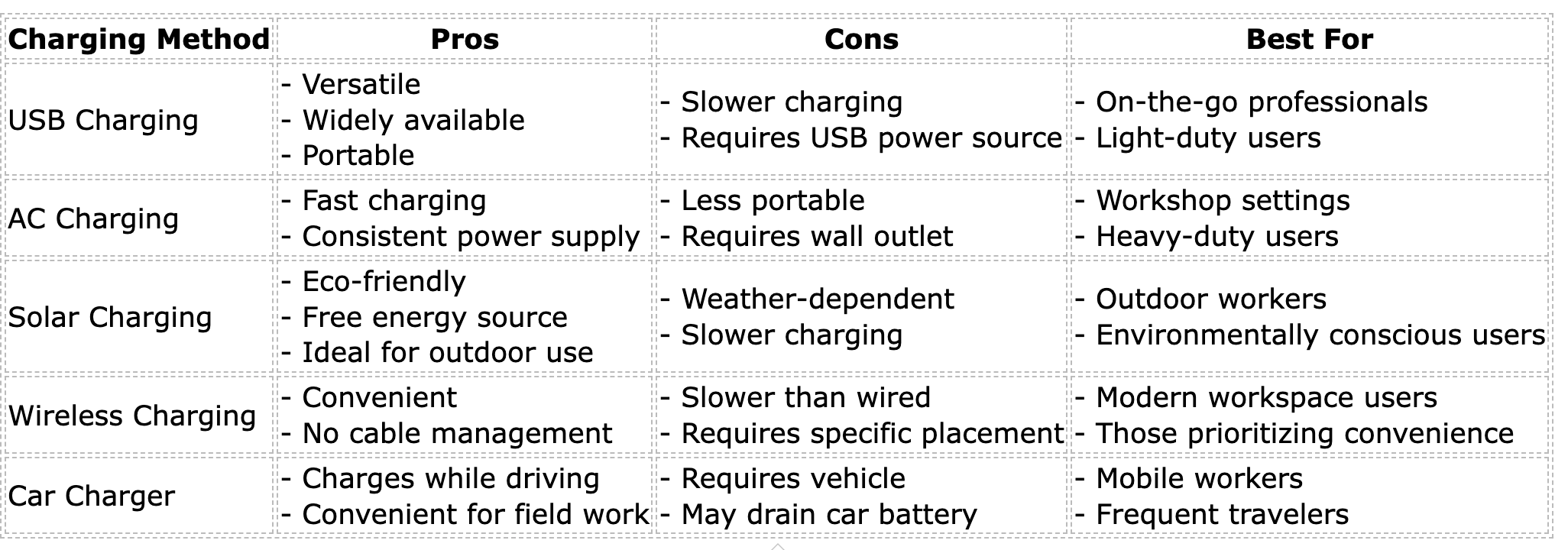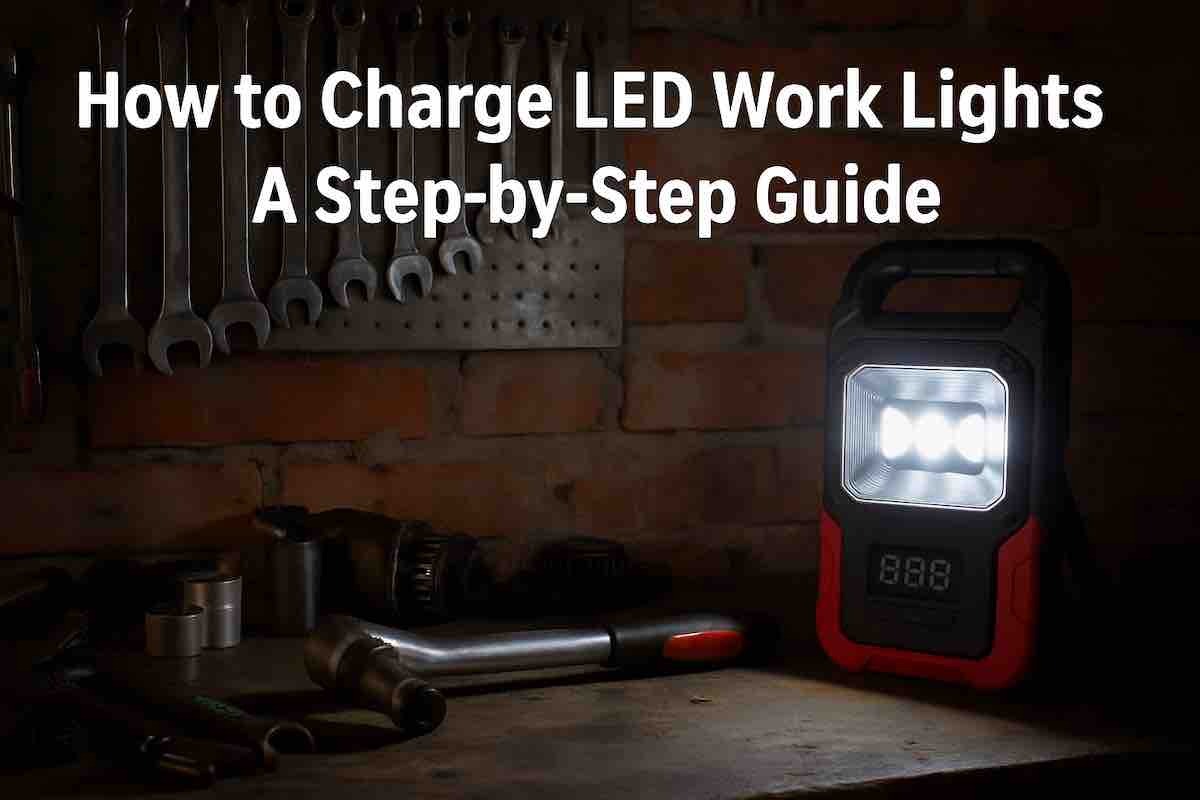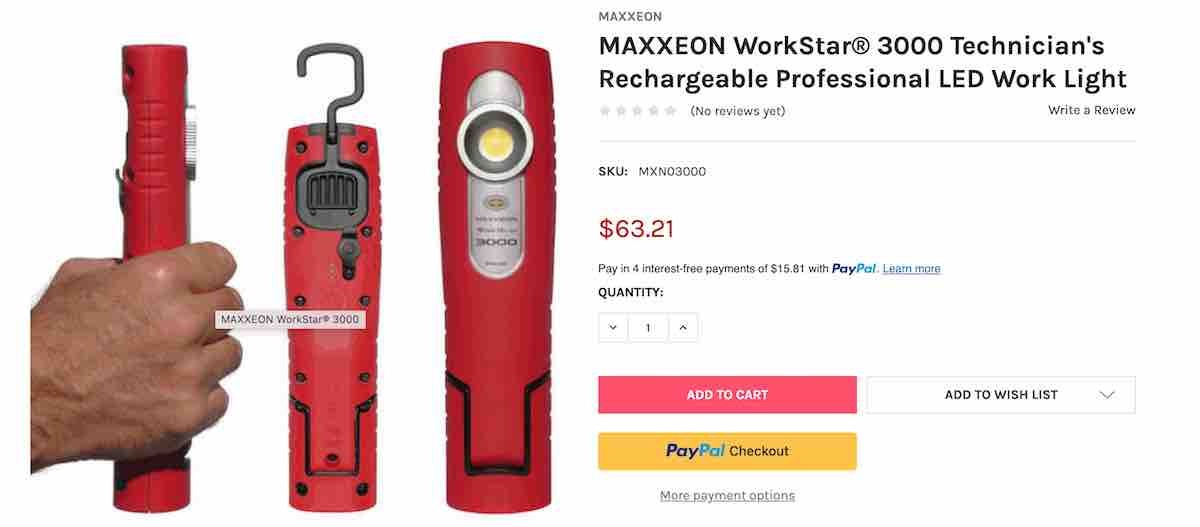How to Charge LED Work Lights: A Step-by-Step Guide
How to Charge LED Work Lights: A Step-by-Step Guide
Imagine you’re deep into a late‑night repair in your Maryland garage when your LED work light suddenly dies—leaving you in the dark and facing costly downtime. With over 611,000 impressions on this topic, it’s clear that professionals and DIYers alike desperately need reliable charging guidance. In this article, you’ll learn:
- Why proper charging maximizes safety, efficiency, and battery longevity
- How to choose and use the right charging method
- Step‑by‑step instructions for all major charger types
- Maintenance, troubleshooting, and product recommendations to keep your lights shining bright
Also Read: How Long Do Rechargeable Light Bulbs Last? – A must‑read if you're planning to upgrade your work light batteries.
The importance of charging LED work lights
Rechargeable LED work lights are essential for many jobs, providing bright and reliable illumination in dark or poorly lit spaces. However, like all electronic devices, LED work lights require regular charging to remain operational and ready for use.
The importance of charging LED work lights must be balanced. Without a fully charged battery, an LED work light will not be able to provide the necessary illumination, which can lead to accidents, mistakes, or delays in completing tasks. In some cases, a depleted battery can even cause damage to the LED work light or reduce its lifespan.
Key Takeaway: Mastering LED Work Light Charging
Proper charging of LED work lights is crucial for optimal performance and longevity. Remember these key points:
- Always use the manufacturer-recommended charging method and equipment.
- Charge before the battery is fully depleted to extend its lifespan.
- Avoid overcharging by disconnecting once fully charged.
- Different charging methods (USB, AC, solar) offer varying benefits - choose based on your work environment.
- Regular maintenance and proper charging can significantly extend your LED work light's life and reliability.
By following these guidelines, you'll ensure your LED work light is always ready when you need it, enhancing safety and productivity in your workspace.
Explore More: Rechargeable Light Bulbs: Advantages and Limitations

Worksight LED Lights to Consider
Trending product Illuminate your workspace
Illuminate your workspace effectively with the powerful HYCHIKA 50W LED Work Light. 1 This portable flood light boasts an impressive 5500 lumens of bright, 5000K daylight illumination and comes with a convenient stand. 1 Its IP65 waterproof rating makes it durable for both outdoor and indoor jobs, including car repairs or construction sites. 1 Grab it now at a special promotional price of $24.64 (15% off the original $28.99)
Affiliate Disclosure: Please note that some of the links provided may be affiliate links. If you click on one of these links and make a purchase, we may earn a small commission at no additional cost to you. This helps support our ability to provide information and recommendations.
Why Proper Charging Matters
A dead work light isn’t just an inconvenience—it costs time, money, and sometimes even safety. In one case study at a busy GZ Supplies auto shop, techs who pre‑charged their high‑output Maxxeon lights saw a 30 % reduction in repair delays over three months.
Learn More: How Do Rechargeable Light Bulbs Work?
Key Benefits of Proper Charging
- Safety First: Under‑lit work areas lead to mistakes and injuries.
- Fuel & Time Savings No more running back and forth for fresh batteries—project flow stays uninterrupted.
- Battery Health Charging before fully drained prevents deep‑cycle damage and extends pack life by up to 50 %.
- Cost Avoidance Replacing worn‑out batteries or entire lights can run $40–$100 per unit.
LED Work Light Charging Methods Comparison

This comparison helps you choose the most suitable charging method based on your specific work environment and needs.
Detailed Steps for Charging LED Work Lights
- Inspect the Work Light
- Check for any damage to the charging port or cable
- Ensure the light is switched off before charging
- Identify the Charging Method
- Refer to the user manual for recommended charging method
- Locate the appropriate charging port on the device
- Prepare the Charging Equipment
- For USB: Ensure you have a compatible USB cable and power source
- For AC: Locate the AC adapter and check for any damage
- For Solar: Clean the solar panel and position in direct sunlight
- Connect the Charger
- Gently insert the charging cable into the work light's port
- For AC charging, plug the adapter into a wall outlet
- For solar charging, ensure proper alignment with sunlight
- Verify Charging Status
- Look for indicator lights showing charging progress
- Green light usually indicates full charge
- Red or orange typically means charging in progress
- Monitor Charging Time
- Refer to the manual for expected charging duration
- Most LED work lights take 3-6 hours for a full charge
- Disconnect When Fully Charged
- Unplug the charger once the indicator shows full charge
- Avoid leaving connected for extended periods after full charge
- Post-Charging Check
- Turn on the work light to ensure it's functioning properly
- Check all modes and brightness levels
- Store Properly
- Keep in a cool, dry place if not using immediately
- For long-term storage, maintain a 40-80% charge
By following these detailed steps, you'll ensure optimal charging and maintain the longevity of your LED work light.
Never Run Out Again: Ultimate Guide to Rechargeable Battery Work Lights
LED Work Light Maintenance Tips for Longevity
- Regular Cleaning
- Wipe down the light body with a damp cloth
- Use compressed air to clear dust from vents and switches
- Battery Care
- Avoid complete discharge; recharge at 20-30% battery life
- Perform a full discharge-recharge cycle every 3 months
- Proper Storage
- Store in a cool, dry place away from direct sunlight
- Remove batteries if storing for extended periods
- Inspection Routine
- Check for loose screws or damaged parts monthly
- Inspect cables and charging ports for wear or damage
- Weather Protection
- Use weather covers when working in wet conditions
- Allow the light to dry completely before charging if exposed to moisture
- Heat Management
- Avoid using in extremely high temperatures
- Ensure proper ventilation during use and charging
- Lens Care
- Clean the lens with a microfiber cloth to maintain brightness
- Check for cracks or scratches that might affect light output
- Software Updates
- For smart LED work lights, regularly check for and install firmware updates
- Accessory Maintenance
- Keep spare parts like O-rings and lens covers on hand
- Regularly clean and inspect any mounting brackets or stands
- Professional Service
- Have your LED work light professionally serviced annually for heavy-duty users
By following these maintenance tips, you'll significantly extend the life of your LED work light and ensure consistent performance.
Fortunately, several different types of charging methods are available for LED work lights, Such as the all-powerful maxxeon LED lights, each with its own benefits and drawbacks. Here is an overview of the most common types of charging strategies for LED work lights:
- USB Charging: Many LED work lights can be charged using a USB cable that connects to a power source such as a computer, wall adapter, or power bank. This method is convenient and allows for charging on the go, making it an excellent choice for those who need to charge their LED work lights while on the job.
- AC Charging: Some LED work lights come with an AC adapter that can be plugged into a wall outlet. This reliable method can provide a quick and consistent charge, making it a good choice for those who need their LED work lights charged quickly.
- Solar Charging: Solar-powered LED work lights use solar panels to convert sunlight into energy, which charges the battery. This method is environmentally friendly and ideal for those who work outdoors or in areas with plenty of sun.
Charging LED work lights is essential to ensure they remain operational and ready for use. Several types of charging methods are available, including USB charging, AC charging, and solar charging, each with its own benefits and drawbacks. By choosing the correct charging method for your needs and following the manufacturer's recommendations, you can ensure that your LED work light is always ready to provide reliable illumination when needed.
Charging LED work lights is an important task that ensures their reliability and longevity. Follow this step-by-step guide to ensure your LED work light is fully charged and ready for use.
- Locate the Charging Port: The first step is to locate the charging port on your LED work light. The charging port is usually on the light's side or bottom. Check the manufacturer's instructions or user manual if you need help finding it.
- Choose the Charging Method: There are several ways to charge LED work lights, including USB charging, AC charging, and solar charging. Choose the method that best suits your needs and the available resources.
- Connect the Charging Cable: If you're using a USB or AC charger, connect the charging cable to the charging port on the LED work light and plug it into a power source. If you use a solar charger, place the LED work light in direct sunlight.
- Check the Charging Status: Most LED work lights have an indicator light that shows the charging status. The light will typically turn red when the battery is charging and turn green when the battery is fully charged. If your LED work light doesn't have an indicator light, check the manufacturer's instructions or user manual to determine the expected charging time.
- Disconnect the Charging Cable: Disconnect the charging cable from the charging port once the LED work light is fully charged. Overcharging the battery can reduce lifespan, so disconnect the charging cable when the LED work light is fully charged.
Following this step-by-step guide, you can ensure your LED work light is fully charged and ready for use. Regularly charging your LED work light is crucial to ensure its reliability and longevity, so charge it as needed and follow the manufacturer's instructions.
Pro Insight: Exploring the Pros and Cons of Rechargeable Light Bulbs
Different Types of Charging Methods
- USB Charging: USB charging is a common method of charging LED work lights. It involves connecting the LED work light to a USB cable that connects to a power source such as a computer, wall adapter, or power bank. USB charging is convenient and allows for charging on the go, making it an excellent choice for those who need to charge their LED work lights while on the job.
- AC Charging: AC charging involves plugging the LED work light into an AC adapter that is then connected to a wall outlet. This method provides a quick and consistent charge, making it a good choice for those who need their LED work lights charged quickly.
- Solar Charging: Solar-powered LED work lights use solar panels to convert sunlight into energy, which charges the battery. This method is environmentally friendly and ideal for those who work outdoors or in areas with plenty of sunlight.
Tips for Charging LED Work Lights
- Charge the LED work light before it's fully depleted: To ensure that your LED work light is always ready for use, it's recommended to charge it before the battery is fully depleted. This will prevent the battery from becoming completely drained, which can reduce its lifespan.
- Use the manufacturer's recommended charger: Using a charger not recommended can lead to problems such as overcharging, undercharging, or even damage to the battery or the LED work light itself. Always use the charger that came with your LED work light or one that the manufacturer recommends.
- Avoid overcharging the LED work light: Overcharging the LED work light can reduce the battery's lifespan and even cause damage to the LED work light itself. Disconnect the charging cable when the LED work light is fully charged to avoid overcharging. Some LED work lights have an automatic shut-off feature that stops charging once the battery is full, so be sure to check if your LED work light has this feature.
Choosing the correct charging method for your LED work light and following the manufacturer's recommendations for charging is essential to ensure the reliability and longevity of your LED work light. By following these tips for charging LED work lights, you can ensure that your LED work light is always ready to provide reliable illumination when needed.
LED Work Light Troubleshooting Guide

If problems persist after trying these solutions, consult the manufacturer's support or seek professional repair services.
LED Tech Trends: New Technologies in LED Lighting
Conclusion
In summary, charging LED work lights is an important task that ensures their reliability and longevity. Follow this step-by-step guide to ensure your LED work light is fully charged and ready for use:
- Locate the charging port
- Choose the charging method
- Connect the charging cable
- Check the charging status
- Disconnect the charging cable
Different types of charging methods are available, including USB charging, AC charging, and solar charging. Choose the way that best suits your needs and the available resources.
Choosing the Right Light: LED Work Lights Buyers Guide
Eco Reads: Eco-Friendly Lighting
To maintain and charge your LED work light correctly, it's essential to follow these tips:
- Charge the LED work light before it's fully depleted.
- Avoid overcharging the LED work light. Use the manufacturer's recommended charger.
By following these tips, you can ensure that your LED work light remains reliable and lasts longer.
In conclusion, maintaining and charging LED work lights is crucial to ensure their reliability and longevity. By following the step-by-step guide and tips outlined in this article, you can ensure that your LED work light is always ready to provide reliable illumination when you need it most.
- Don’t wait for a dead light—charge proactively.
- Pick the right charger: USB for portability, AC for speed, solar for off‑grid.
- Maintain regularly: cleaning, cycling, storing correctly.
- Troubleshoot fast with our quick‑fix table.
Frequently Asked Questions About Charging LED Work Lights
- Q: How long does it typically take to fully charge an LED work light? A: The charging time for LED work lights varies depending on the battery capacity and charging method. On average, most LED work lights take between 3 to 6 hours to fully charge. However, some high-capacity models may take up to 8 hours, while quick-charge models might fully charge in as little as 1-2 hours. Always refer to your specific model's user manual for the most accurate charging time.
- Q: Can I use any USB charger to charge my LED work light? A: While many LED work lights can be charged using standard USB chargers, it's best to use the charger that came with your device or one recommended by the manufacturer. Using an incompatible charger may result in slower charging times, reduced battery life, or even damage to your work light. If you must use a different charger, ensure it matches the voltage and amperage specifications of your LED work light.
- Q: Is it safe to leave my LED work light charging overnight? A: Most modern LED work lights have built-in overcharge protection, making it generally safe to leave them charging overnight. However, as a best practice, it's recommended to unplug the device once it's fully charged. This not only conserves energy but also helps prolong the overall lifespan of the battery. If you need to charge overnight, consider using a smart charger with an automatic shut-off feature for added safety.
- Q: How can I extend the battery life of my LED work light? A: To maximize your LED work light's battery life:
- Avoid completely draining the battery before recharging
- Store the light in a cool, dry place when not in use
- Perform a full charge cycle (complete discharge and recharge) every 3 months
- Use the appropriate brightness setting for your needs, as higher settings consume more power
- Keep the work light clean and free from dust and debris
- Avoid exposing the light to extreme temperatures
- Q: My LED work light isn't holding a charge as long as it used to. What should I do? A: If your LED work light's battery life is noticeably shorter:
- First, try performing a full discharge and recharge cycle
- Check if there's a firmware update available for your model
- Clean the charging port and ensure a solid connection when charging
- If the issue persists, the battery may be degrading. Contact the manufacturer about battery replacement options or consider professional repair services
- For lights with replaceable batteries, consider purchasing a new battery pack
For more lighting tech, visit our blog homepage and discover everything from grow lights to task lamps:
Fluorescent vs. LED Grow Lights
Remember, proper maintenance and charging habits can significantly extend the life of your LED work light and its battery.
Recent Posts
-
The Best Air‑Impact Wrench on Amazon Is Made in Japan—Here’s Why You’ve Probably Never Heard of It
The Best Air‑Impact Wrench on Amazon Is Made in Japan—Here’s Why You’ve Probably N …25th Apr 2025 -
The Best Budget-Friendly Hand Tools for DIY Beginners: A Complete Guide
When I started DIY projects, I made the classic newbie mistake: rushing to buy expensive tools I did …20th Apr 2025 -
The Best Jump Starters in the USA 2024: Tested and Trusted by Tend Industrial Supplies
The Best Jump Starters in the USA 2024 Getting stranded with a dead car battery is a frustrating and …20th Apr 2025










